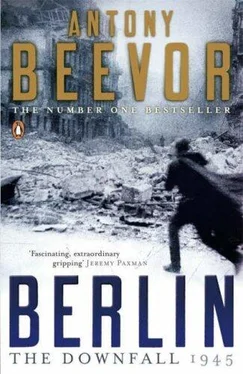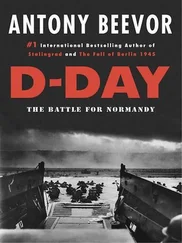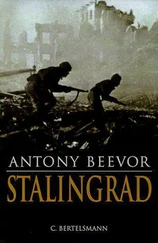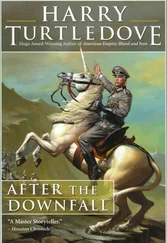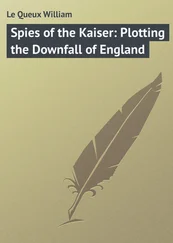Hitler was obsessed with the idea of holding on to the defence line of the Masurian Lakes. He became incandescent with rage when he heard that General Hossbach, the Fourth Army commander, had abandoned its corner stone, the fortress of Lötzen, on 24 January. Even Guderian was shaken by the news. But both Hossbach and his superior, General Reinhardt, were determined to break Rokossovsky’s encirclement and avoid another Stalingrad. Their attack, a battering ram to allow civilians to escape too, began on the clear, freezing night of 26 January. The sudden offensive smashed the Soviet 48th Army and almost reached Elbing, which the German Second Army had managed to hold after the first tank skirmish in its streets. But within three days of fighting in fierce cold and deep snow, Rokossovsky’s armies had fought back the thrust. Hitler sacked both Reinhardt and Hossbach, whose divisions were now forced backwards into what became known as the Heiligenbeil Kessel or cauldron, an awkward quadrilateral with its back to the Frisches Haff. Over 600,000 civilians were also trapped in it.
The 3rd Belorussian Front had meanwhile surrounded Königsberg entirely on the landward side. The city’s large garrison from the Third Panzer Army was thus cut off from the Samland Peninsula, which led to the small Baltic port of Pillau at the mouth of the lagoon. Close to 200,000 civilians were also trapped in the city with little to eat. This policy forced over 2,000 women and children a day to undertake the hazardous journey on foot, over the ice, to an already desperately overcrowded Pillau. Hundreds even walked out into the snow towards the Soviet troops to beg for food and throw themselves on their dubious mercy. The first steamer from Pillau taking 1,800 civilians and 1,200 wounded did not reach safety until 29 January. Gauleiter Koch, having condemned Generals Reinhardt and Hossbach for attempting to break out of East Prussia and having ordered the defenders of Königsberg to fight to the last man, fled his own capital. After a visit to Berlin, he then returned to the far safer Pillau, where he made a great show of organizing the marine evacuation using Kriegsmarine radio communications, before once more getting away himself.
Pillau could not handle very large ships, so the chief seaport for evacuations from the Baltic coast was Gdynia (or Gotenhafen), just north of Danzig. Grand Admiral Dönitz gave the order only on 21 January for Operation Hannibal, a mass evacuation of refugees using four large ships. On 30 January, Germany’s largest ‘Strength through Joy’ sea-cruise liner, the Wilhelm Gustloff , which had been designed to take 2,000 passengers, left with between 6,600 and 9,000 people aboard. That night, escorted by a single motor torpedo boat, it was stalked by a Soviet submarine of the Baltic Fleet. Captain A.I. Marinesco fired three torpedoes. All hit their target. Exhausted refugees, shaken from their sleep, panicked. There was a desperate rush to reach the lifeboats. Many were cut off below as the icy sea rushed in: the air temperature outside was minus eighteen Celsius. The lifeboats which had been launched were upset by desperate refugees leaping from the ship’s side. The ship sank in less than an hour. Between 5,300 and 7,400 people lost their lives. The 1,300 survivors were rescued by vessels, led by the heavy cruiser Admiral Hipper. It was the greatest maritime disaster in history.
Russian historians, even today, still stick to the official Soviet line and claim that the ship carried ‘over 6,000 Hitlerites on board, of which 3,700 were submariners’. The main interest in Russia seems to be not in the fate of the victims, but in that of the triumphant submarine commander A. I. Marinesco. The recommendation to make him a Hero of the Soviet Union was refused by the NKVD, because he had had an affair with a foreign citizen, a crime for which he narrowly escaped a tribunal and an automatic sentence to the Gulag. Only in 1990, ‘on the eve of the forty-fifth anniversary of the victory’, was he finally and posthumously made a Hero of the Soviet Union.
One of the side effects of the mass migration was a fuel and transport crisis in Germany. Coal supplies had been interrupted by the need for wagons to bring refugees through Pomerania. In some places bakers were unable to bake their bread. The general situation was now so desperate that, ‘in order to save the Reich’, full priority on goods trains was taken back from refugees and returned to the Wehrmacht and fuel distribution. This decision was made on 30 January, the twelfth anniversary of the Nazi Party’s arrival in power.
Some generals regarded civilian refugees, not with pity as the chief victims of Soviet revenge for the Wehrmacht’s invasion, but simply as a severe nuisance. One of Hitler’s most favoured commanders, General Schörner, had given orders that a thirty-kilometre zone on the east bank of the upper Oder should be reserved for military operations. He also complained loudly that refugees were hindering military activity, and requested an order from Field Marshal Keitel that ‘evacuations must now cease’. This presumably meant that he was prepared to take punitive measures against civilians fleeing from the Red Army.
National Socialist authorities at times treated German refugees almost as badly as concentration camp prisoners. Local administrators, the Kreisleiters, evaded responsibility for them, especially if they were sick. Three goods trains took refugees crammed in open wagons to Schleswig-Holstein. One train alone carried 3,500 people, mainly women and children. ‘These people were in a dreadful state,’ a report stated. ‘They were riddled with lice and had many diseases such as scabies. After the long journey there were still many dead lying in the wagons. Often the contents of the trains were not offloaded at their destination but sent on to another Gau. Apart from that everything is in order in Schleswig-Holstein.’
Hitler himself decided that it would be a good idea to fill the ‘Protectorate’ of occupied Czechoslovakia with German refugees. ‘He is of the opinion,’ explained an official, ‘that if the Czechs see the misery, they will not be tilted into a resistance movement.’ This turned out to be yet another miscalculation of intention and effect. A report came back less than three weeks later warning that the Czechs, on seeing this proof of German defeat, were wasting no time in preparing their own administration, to be led by Beneš.
The crisis of National Socialism did not fail to affect the army. Hitler convinced himself that all would be well if a sufficiently ruthless and ideological military leader were appointed to defend the Reich in the east. General Guderian could scarcely believe his ears when Hitler decided on 24 January that Himmler, the Reichsführer SS, was to command the new Army Group Vistula between East Prussia and the remnants of Reinhardt’s shattered army group in Silesia. Hitler’s decision was also no doubt influenced by his threat to Guderian of a few days before to smash ‘the general staff system’, and revenge himself on a ‘group of intellectuals’ who presumed ‘to press their views on their superiors’.
That afternoon, Colonel Hans Georg Eismann of the general staff received orders to proceed to Schneidemühl. He was to be the chief operations officer at the headquarters of Army Group Vistula. Eismann had never heard of such an army group. The general in charge of staff officer postings explained to him that it had just been constituted. Eismann heard with just as much astonishment as Guderian that Himmler was to be its commander-in-chief.
Eismann had no choice but to set off eastwards that evening by Kübelwagen, the hefty German equivalent of the jeep. As they drove through the freezing night out along Reichsstrasse 1, ‘the whole extent of the chaos and misery’ became clear to him. ‘Along all roads could be seen endless convoys of refugees from the east.’ Most gave an impression of exhausted aimlessness.
Читать дальше
